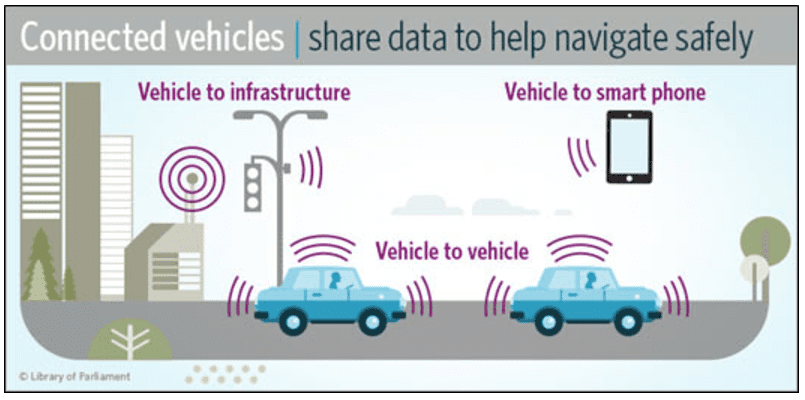Connected Vehicles: How Innovative Technology is Driving the Market

Smart, connected vehicles are transforming the global automotive industry. Consumers are now looking for technologically-advanced vehicles to support a ‘connected lifestyle’ where they can still be entertained, productive, and safe behind the wheel. Automotive manufacturers should take note of this shift and offer new valuable products or services to serve the connected vehicle market.
There are several ways that connected vehicles (CVs) can revolutionize the automotive market. This includes CVs with vehicle-to-vehicle data exchange which improves driver safety, vehicle-to-infrastructure data exchange which helps improve traffic flow and reduce congestion, and vehicle-to-internet data exchange where drivers can install and use software applications. Each feature provided through connected vehicle technologies improves the driver experience and leads to higher customer satisfaction.
While traditional automotive companies have already begun developing connected products and services, technology developers are also looking to access this market. Ultimately, only the most innovative technologies will make it into new generations of connected vehicles. Canadian automotive manufacturers need to be aware of this trend; begin strategically investing into vehicle hardware and software so that you can capitalize on shifting consumer preferences.
LEARN MORE ABOUT THE TOP 4 TRENDS IN THE CANADIAN AUTOMOTIVE SECTOR
Connected Vehicles: What’s Driving the Market?
Connected vehicles are a growing automotive trend because of consumers wanting better-integrated hardware and software platforms. Consumers want to be given control over their driving experience but also want to improve safety and reduce the potential for an accident to happen.

Autonomous vehicles are distinctly different than connected vehicles, but will share similar technologies. Connected vehicle drivers still need to remain aware of their surroundings, but the vehicle will be able to use data to make decisions as needed. This is unlike autonomous vehicles that are expected to operate on their own with minimal operator input. As autonomous vehicles gain popularity in the future, many of the technologies developed for connected vehicles will be adapted or adopted and used to improve the autonomous driving experience.
For this reason, automotive manufacturers should be focusing technology investments on the connected vehicle market. Some of the biggest opportunities in this space include:
Vehicle-to-Vehicle Automotive Technologies
Vehicle-to-vehicle communication allows vehicles to share their location, direction, speed, brake status and other information in real time with other similarly connected vehicles.
These types of technologies provide advanced safety systems and can help to proactively avoid dangerous road conditions. For example, if an object is blocking part of a lane and requires drivers to swerve and avoid it, vehicles may recognize this consistent pattern and prompt a driver that additional attention is needed for the upcoming stretch of road.
Vehicle-to-Infrastructure Automotive Technologies
Vehicle-to-infrastructure communication allows smart roadway infrastructure equipped with CV technology (like traffic signals, roadway signage, border and rail grade crossings) to exchange information in real time with vehicles and smart phones.
These types of technologies provide safety and convenience benefits to drivers. For example, a vehicle may use data from traffic signals or stop signs to alert its driver if another car is about to run the intersection. Alternately, transportation infrastructure can be optimized based on the data collected from vehicles. Transportation engineers can modify traffic signalling to improve vehicle flow and reduce congestion, ultimately helping drivers access an optimal driving route.
Vehicle-to-Smartphone Automotive Technologies
Vehicle to smartphone communication is generally to describe vehicles with telecommunication capabilities. This can include innovations such as enhanced navigation via global positioning system (GPS) communications, mobile Internet, infotainment (like hands-free communications and in-car entertainment) and remote software.
While GPS systems are the most common types of vehicle to smart phone technologies commonly used today, tech developers are discovering new ways for drivers to remain productive while driving. The development of new software and applications compatible with vehicles will enable drivers to remain connected with social networks and perform other types of tasks without visual distraction.
Opportunities for Connected Vehicle Technology Investments
Investing in connected vehicle technologies is critical for automotive manufacturers to remain competitive in this emerging market. Providing products and services for CVs will help generate new revenue streams and improve the company’s image as an industry innovator.
There are incredible opportunities available to improve current connected vehicle technologies, including:
- Establishing driver alert/warning systems;
- Developing vehicle sensor or data exchange technologies;
- Developing/adapting software to be usable by a vehicle driver; and
- Developing/integrating connected infrastructure for public use.
Fortunately, government funding for manufacturers can help to reduce the cost of automotive technology investments.
Government grants and loans can offset a portion of project expenses related to research and development, hiring and training, and capital investments; all of which are required to compete in the connected car market.
Top 4 Trends in The Canadian Automotive Sector
Connected vehicle technologies are just one of the major trends impacting the Canadian automotive sector. Automotive manufacturers can learn more about the emergence of CVs, in addition to three other trends, by downloading Mentor Works’ Top 4 Trends in The Canadian Automotive Sector white paper.

